Sustainability Game
Yellowstar Solutions & Big Mile Project
Game: The Sustainability Game was a project planned by Yellowstar Solutions and Big Mile to make their clients aware of their CO2 emissions when ordering something and what happens in its supply chain.
Genre: Supply Chain Sim, Simulation Game, Mini Games.
Platform: PC
Engine: Made in Unreal with Character Art, UI Art, and Data provided by Insource Colleagues of Yellowstar and Big Mile through Google Drive.
Development Time: In the last year at BUAS, we had to do a year of internships. Throughout this year, I worked full-time on the project, with some weeks spent on school documentation. After the internship, I was given a contract for another half year with the agreement that I would also work on other things for Yellowstar, giving me less time to work on the game in general. The total time spent on the game counts up to 54 weeks.
Team Members: 1 Designer (Me) - 1 Programmer (Me) - 1 Character Artist (Insource) - 1 UI Artist (Insource) - 1 Marketing (Insource) - 2 Misc. Insource.
Origin: Yellowstar and Big Mile wanted to make a sustainability game together that taught their clients about their CO2 emissions, but as an ICT company, Yellowstar did not get the okey to hire game developers. As a way to still try it out, they decided to ask a single game design student as an intern to make the game; instead, this student was me. They asked me as an intern through LinkedIn, and I accepted because I thought it would be a good learning opportunity.
My Responsibilities:
-
Prototyping.
-
Designing and programming using blueprints.
-
Optimization.
-
Guiding Non-Experienced Insources.
-
UI/UX and Tutorial Functionality.
-
Leading Meetings.
-
Setting up playtests and QA.
-
Making and updating builds.
-
Having the lead and producer roles for the insource that had no game experience.
The first thing I had planned out was a saving system. This included the main menu with a new game and continue button, and tutorials that would only show up once after pressing the new game. The score that the player got previously would also be saved.


The briefing mentioned that they wanted to include minigames and objectives, but I decided to make an interactive hub first where these minigames and objectives could be chosen. During information gathering, I learned that a lot of office workers wished they could throw chairs and tables around, so I added this to the hub for fun and stress relief to also attract their attention.

After the first build that was made to run on a bad laptop the company could use for their clients to play on, it became obvious that these laptops were not made to play games on. This was the first time I had to optimize a game, and it came with a settings menu that I made in case people with better machines would play it.
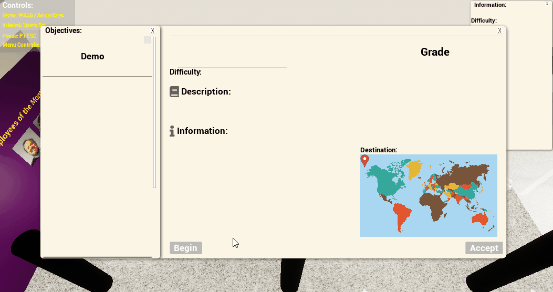
When opening the computer, the player will get a list of objectives they can choose from. After starting the objective, they will have to select where they want to order from and how to get it delivered to their location. Each choice has different stats and minigames associated with it; these stats and minigames will determine the player's score at the end.
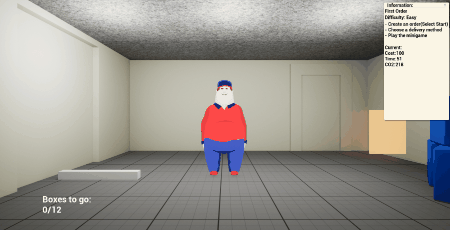
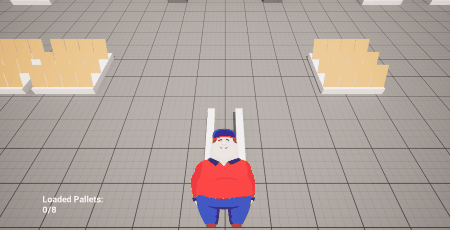
I was told that they wanted this game to have minigames, representing things that happen during delivery, in it as well, so I started off with prototyping the following 4. This game represents the section of the supply chain where the ordered goods are put on a pallet for shipment. Moving too fast will let you drop a box, and once dropped, it breaks and cannot be picked up again.
For the second minigame, I prototyped an easy puzzle-esque game that represents loading the pallets onto a container for transport. The people that would play this game are company higher-ups; I couldn't make these minigames too complicated to complete. They wouldn't have much time to play the game either; it had to be beatable within 10 minutes, and the difficulty had to compensate for it.
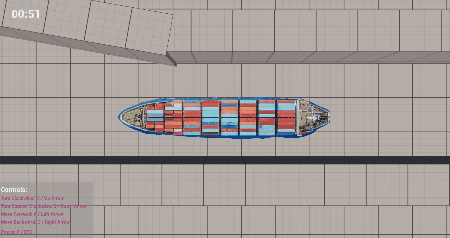
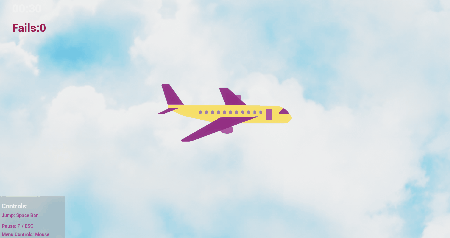
The minigame with the boat was inspired by a container ship that got stuck in the Suez Canal. Representing the sea travel part of the supply chain, the player has to navigate the container ship through the Suez Canal as fast as possible without getting stuck, as that will take more time.
The last prototype I made was for air travel, which replaces sea travel if that delivery option is chosen. Taking inspiration from flappy bird, the goal is to survive until the time runs out (which represents the travel time). Depending on the objective, this could be the worst option to choose because of the amount of CO2 airplanes emit.

There was an insource that provided all the data needed to make the sustainability game as precise as possible. Besides the costs, the insource gave where certain things could be bought, how it would get to the target, the CO2 emissions it would make, and how many days it would take to get there. This data then had to be inserted into a data table in Unreal, which I then had to update with the data needed for it to be implemented into a modular system so that anybody could add new objectives and minigames to the game. A data table was also created for the tutorials for the same reason.

The human character used was designed by the marketing insource that wanted to use him in the future of the company. However, the images they had of him were not usable for me in the game, so I requested that they make walking animations of him, but because they had no game or animation experience, I had to run them through what I needed with references and explanations.
I also had to discuss and join company meetings where stuff surrounding the game was being discussed. For example, one of these meetings was regarding the release date for the game. During the meeting, marketing said they wanted to announce the game after four months of development. In that case, I had to step in because of the knowledge I had that games would not be announced that quickly, especially in a project where one person would have to do most of the work. Because of this, they held off on the reveal for another year.